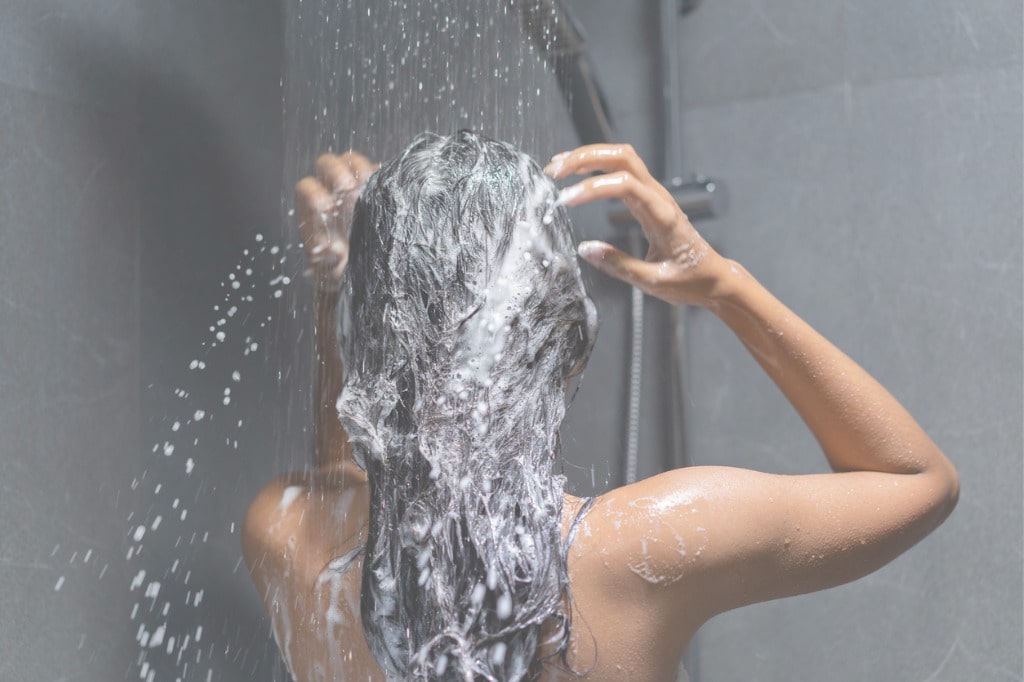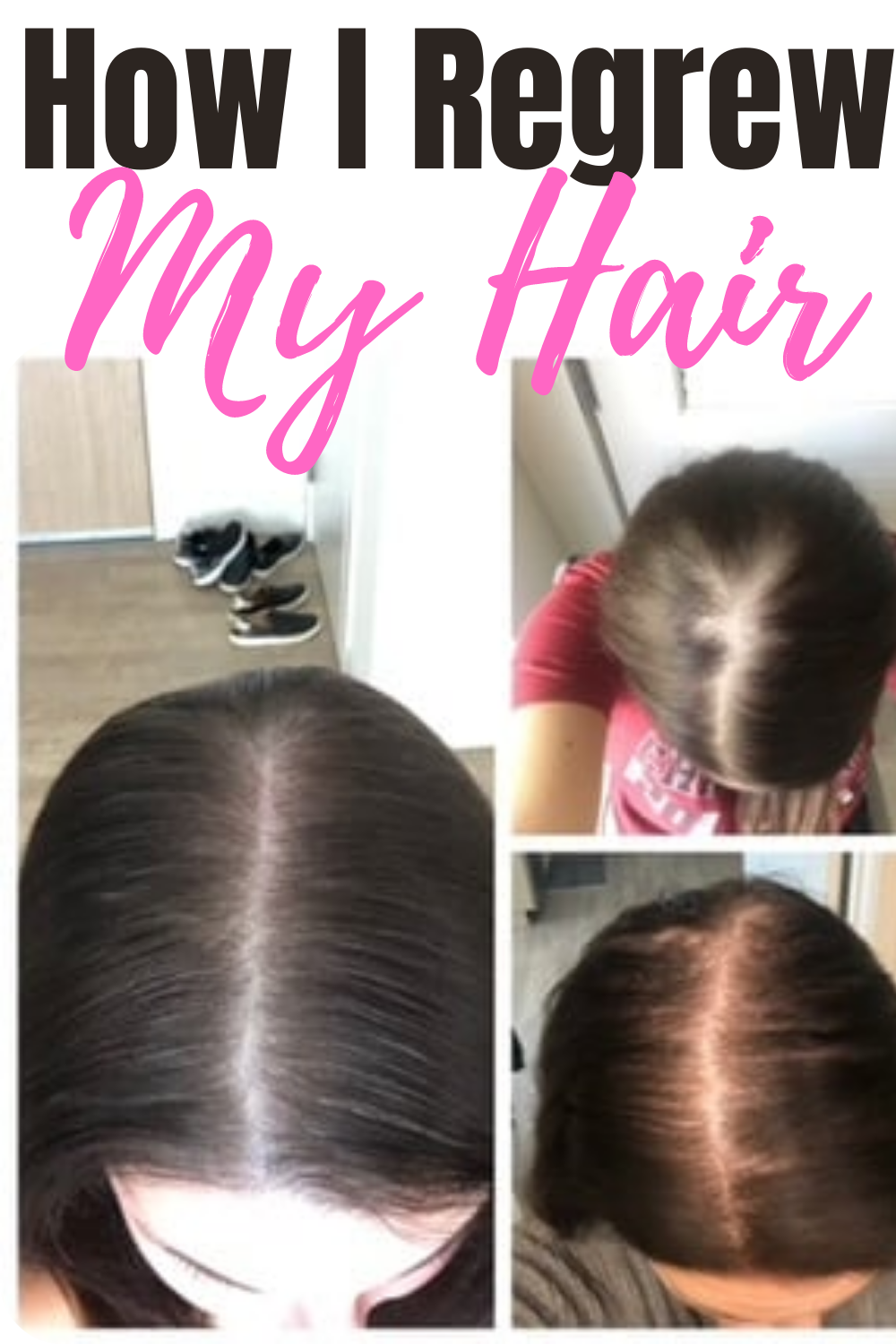This post may contain affiliate links, which means I'll receive a commission if you purchase through my link, at no extra cost to you. Please read full disclosure here.

Why I use Ketoconazole Shampoo 3x a week.....
Are you looking for a shampoo to incorporate into your hair care routine that has been studied in people experiencing hair loss from androgenic alopecia?
With so many shampoo products on the market with tons of different ingredients claiming to combat hair loss and hair thinning it can be hard to know what one to choose.
When I do a quick google search, I can find "shampoo for hair loss" products highlighting their preservative free system, vitamin blends, natural extracts, plant-derived ingredients, premium oils, and Dihydrotestosterone (DHT) blocking effects.
WHAT ACTUALLY MATTERS?
WHAT'S ACTUALLY BEEN STUDIED IN A CLINICAL SETTING?
Let's filter out the buzzwords that make all of us sparsely-haired women foam at the mouth and get down to the root of the problem. (I'm sorry I couldn't help myself.)
In this post I review some of the data surrounding topical ketoconazole and the effect of long-term use of ketoconazole shampoo in individuals with androgenic alopecia.
If you don't want to read through all the data then feel free to skip to the end where I detail my own routine with this shampoo. You can see my own personal results on my ABOUT page from incorporating this shampoo as part of my own hair loss prevention routine in combination with treatments like topical minoxidil and laser therapy.
Disclaimer. I am not a medical doctor. Please talk to your physician before making any changes to your own routine.
Okay, now back to ketoconazole...
Maybe you’re thinking...Wait... Isn’t ketoconazole the anti-dandruff shampoo?
Ding ding ding!
You are correct.
You can find ketoconazole over the counter and also available from your doctor by prescription.
It is also highly effective in treating seborrheic dermatitis (this is a skin condition that involves scaly patches to form mainly on the scalp that are red in color).
I have linked the one I use HERE. You can also click on the image. But please note: 2% ketoconazole was used in the studies I detail below. The product I have linked is a 1% formulation.
But how is ketoconazole thought to work against hair loss?
It kind of targets hair loss from a few different directions...
Ketoconazole is an anti-fungal drug with anti-inflammatory properties (1).
It also has anti-androgenic properties and this is the most commonly proposed mechanism for how it works in androgenic alopecia (1).
We know that androgenic alopecia is caused by a genetic predisposition along with hormones such as androgens, testosterone, and testosterones conversion into Dihydrotestosterone (DHT) in the hair follicles (2). So applying ketoconazole to the scalp might be able to combat androgen-related hair loss (3).
.
If you want to know exactly how I regrew my hair over the past year then check out my e-Book linked in the image above. This e-Book features exclusive content that is not featured on my blog.
Talk Data To Me...
But before we jump in...This first study is all about topical ketoconazole. (Not the shampoo... That data is coming up after this study).
You can stalk the study we are about to review HERE. Get excited because this one was actually conducted in women!
The aim of this study was to evaluate the safety and efficacy of ketoconazole in people with female pattern hair loss.
When I say “evaluate the efficacy” I mean that the authors are trying to determine if there was a possible hair growing effect of ketoconazole.
The set up:
This was a blinded study. (So the women did not know what treatment group they had been assigned to).
Patients with female pattern hair loss were randomly assigned to the following treatment groups:
Group A: 20 female patients received 2% topical minoxidil solution---they applied 1mL per day for 6 months
Group B: 20 female patients who were treated by 2% topical ketoconazole preparation. This was not a shampoo. They applied 1mL per day of the 2% ketoconazole preparation to their scalp for 6 months
These patients were assessed clinically but also by trichoscopy. What's that? Think of this as a super magnified way to look at the hair and scalp. The authors also measured side effects along with patients’ satisfaction.
Some results that stood out to me...
For Group A (Minoxidil Group)- The authors found that there was a significant difference detected between the beginning of the study and at months 4 and 6 in regards to hair growth
For Group B (2% ketoconazole)-the improvement in hair growth was delayed until the 6th month. So the improvement was still found to be statistically significant... but only when comparing the disease severity at that initial visit to the disease severity at the end of month 6.
What about the side effects?
55% of the minoxidil group reported side effects
10% of the ketoconozole group reported side effects
Side effects looked at were dermatitis and hypertrichosis, or a combination of both
A few things you may want to consider...
The women included in this study were between 18-65 years
The women in the study had all grades of disease severity
THERE WERE ONLY WOMEN IN THIS STUDY
None of the women who were included in this study were pregnant, lactating or had used any hair-restoration treatments within the past 6 months.
This was a small study with only 20 women per treatment group
Topical 2% ketoconazole did show hair stimulating effects. But it was a delayed improvement in hair growth when compared to minoxidil 2%.
The Ketoconazole group experienced less side effects than the minoxidil group

Um...But wasn't this post about shampoo?
Here's a shampoo study for you... This study was conducted in men and the study aimed to determine if Ketoconazole may improve alopecia (4).
You can stalk the study HERE.
Now this paper reports on two studies.
I’m not going to go into as many details as I did in the previous review but below I give an overview of the set up of the treatment groups and then I sum up the overall findings.
Here is the set up for Study 1:
Study 1 included a total of 39 men with androgenic alopecia
27 of these men used 2% ketoconazole shampoo 2-4 times weekly over a 21 month period.
12 men in the study used an unmedicated shampoo in a similar way
None of the men had applied products to influence hair growth either before or during the study.
Here is the set up for Study 2:
Study two contained 2 groups of 4 men. The treatment period was 6 months.
One group used 2% Ketoconazole shampoo
The other group used a combination of 2% minoxidil applied once daily and unmedicated shampoo.
Sum it all up. What did both of these studies reported in this paper find?
The authors found that hair density and proportion of anagen follicles were much improved by the long-term use of a 2% ketoconazole containing shampoo in male pattern hair loss without any associated seborrheic dermatitis or dandruff.
Similar improvement levels to topical minoxidil at the 2% concentration were also reported.
What about if you combine ketoconazole shampoo with other treatment methods?
Let's talk about combining treatments.
One study enrolled 100 male patients with androgenic alopecia. The goal was to evaluate and compare the efficacy of oral finasteride (1 mg per day), topical 2% minoxidil solution and topical 2% ketoconazole shampoo alone and in combination (5).
The authors found when you use oral finasteride and combine it with a 2% ketoconazole shampoo hair regrowth was induced in male pattern hair loss.
Stalk the study HERE for more details.
In a different study.....
A prospective pilot study conducted in 15 male patients with androgenic alopecia also looked at the effect on hair growth when aggressively treating alopecia by combining Nuh Hair, Rogaine foam, Propecia, and ketoconazole shampoo.
The authors reported that the patients that followed this regimen showed significant growth which was achieved in as little as 30 days (6).
You can stalk the study HERE for more details.
Still hungry for more?
Below is a literature review of topical ketoconazole in androgenic alopecia.
Stalk the study HERE. This review contains 5 human studies and 2 animal studies. The total participants in the human studies were 318 participants.
The authors concluded that ketoconazole is a promising adjunctive or alternative therapy in treating androgenic alopecia.
But they did also highlight that randomized controlled trials are needed. (7).
My Treatment Regimen...
Here is how I incorporate ketoconazole shampoo into my own hair loss treatment routine.
I currently use the ketoconazole shampoo I have linked HERE on my own hair about 3x per week. I leave it on my scalp and get a good lather going using my scalp massager which I have linked HERE.
The way I use this to massage my head is by applying different amounts of pressure as I push down on the silicon bristles and just kind of jiggle it a bit lol. I just like that I could use the word “jiggle” in this post.
But anyways... Then I pick up the massager and move to the next location on my head. For more information about why I make sure to massage my scalp, daily see my blog post HERE.
I don’t rub this massager against my head really rapidly because I’m not trying to create tons of tangles. I leave the shampoo on my head for about 4 minutes total.
Just a heads up...
I’ve found that this shampoo can leave my hair feeling dry. To try and fix that I just massage it into my scalp without really working it down to the ends of my hair.
I’ve also added a deep conditioner to my routine as well by Pureology that I’ve linked HERE. Please note: I just use this deep conditioner because I think it works great and leaves my hair feeling soft and hydrated. Not because of anything related to hair loss.
I've also added Olaplex No. 3 linked above to my routine to combat my dry hair. What I think is important to call out with this product is that it is not a conditioner. This is a bond builder so you'd want to use it before shampooing. Apply it on damp towel dried hair and leave it on your hair for a minimum of ten minutes. You can go longer if desired. I use this product about once per week but if your hair is especially damaged then try 2-3x week as suggested on the bottle.
And there you have it!
2) El-Garf, A., Mohie, M. & Salah, E. Trichogenic effect of topical ketoconazole versus minoxidil 2% in female pattern hair loss: a clinical and trichoscopic evaluation. biomed dermatol3, 8 (2019). https://doi.org/10.1186/s41702-019-0046-y
3) Sonino N, Scaroni C, Biason A, Boscaro M, Mantero F. Low-dose ketoconazole treatment in hirsute women. J Endocrinol Invest. 1990 Jan;13(1):35-40. doi: 10.1007/BF03348578. PMID: 2138647.
4)Piérard-Franchimont C, De Doncker P, Cauwenbergh G, Piérard GE. Ketoconazole shampoo: effect of long-term use in androgenic alopecia. Dermatology. 1998;196(4):474-7. doi: 10.1159/000017954. PMID: 9669136.
5) Khandpur S, Suman M, Reddy BS. Comparative efficacy of various treatment regimens for androgenetic alopecia in men. J Dermatol. 2002 Aug;29(8):489-98. doi: 10.1111/j.1346-8138.2002.tb00314.x. PMID: 12227482.
6) Rafi, A W, and R M Katz. “Pilot Study of 15 Patients Receiving a New Treatment Regimen for Androgenic Alopecia: The Effects of Atopy on AGA.” ISRN dermatology vol. 2011 (2011): 241953. doi:10.5402/2011/241953
7)Fields JR, Vonu PM, Monir RL, Schoch JJ. Topical ketoconazole for the treatment of androgenetic alopecia: A systematic review. Dermatol Ther. 2020 Jan;33(1):e13202. doi: 10.1111/dth.13202. Epub 2020 Jan 2. PMID: 31858672.




